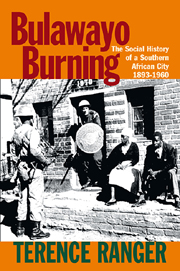Book contents
- Frontmatter
- Contents
- List of Illustrations
- Introduction
- Prelude: Bulawayo, 1893–1930
- 1 The Landscapes of Bulawayo
- 2 The First Fires: December 1929
- 3 City versus State 1930–1946
- 4 Mr Black Bulawayo 1930–1948
- 5 The Feminization of Black Bulawayo 1948–1960
- 6 Black Bulawayo Transformed
- 7 Black Bulawayo Burns 1960
- Postlude: Bulawayo after 1960
- Selected Bibliography
- Index
Postlude: Bulawayo after 1960
Published online by Cambridge University Press: 05 April 2013
- Frontmatter
- Contents
- List of Illustrations
- Introduction
- Prelude: Bulawayo, 1893–1930
- 1 The Landscapes of Bulawayo
- 2 The First Fires: December 1929
- 3 City versus State 1930–1946
- 4 Mr Black Bulawayo 1930–1948
- 5 The Feminization of Black Bulawayo 1948–1960
- 6 Black Bulawayo Transformed
- 7 Black Bulawayo Burns 1960
- Postlude: Bulawayo after 1960
- Selected Bibliography
- Index
Summary
I hope that readers who have followed my narrative and its characters thus far will want to know what happened next. To do that properly they will have to wait, I fear, for another book by another author. But I should indicate briefly here how the history of Bulawayo between 1893 and 1960 relates to the history of the city between 1960 and 2010. There have been both disjunctions and continuities.
Although so many people feared – and a few hoped for – a repetition of the Zhii riots they turned out in fact to be the last great upheaval of colonial Bulawayo. Nkomo, Moyo and the other nationalist leaders managed to hold together their fractured movement. When the NDP was banned in 1961 there was a smooth transition in Bulawayo to the Zimbabwe African People's Union (ZAPU). When ZAPU was challenged in 1963 and 1964 by the Zimbabwe African National Union there was savage interparty fighting in the African townships of Salisbury. But Bulawayo remained solid for ZAPU and Nkomo's leadership. When the ZAPU leadership was removed Bulawayo remained quiescent. Historians have not yet explored the interactions between the cities and the guerrilla war and there will doubtless be a hidden story to tell. But on the face of it black Bulawayo was in many ways subdued in the 1960s and 1970s. Not only the nationalist movement but also the trade union movement was effectively repressed. The vibrant musical and cultural life of black Bulawayo was dampened, as singers like Dorothy Masuka left the country.
- Type
- Chapter
- Information
- Bulawayo BurningThe Social History of a Southern African City, 1893–1960, pp. 244 - 250Publisher: Boydell & BrewerPrint publication year: 2010



